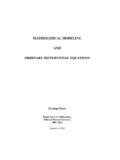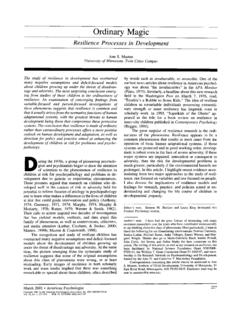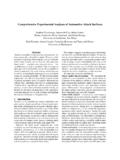Transcription of Unification of ordinary portland cement codes
1 POINT OF VIEW. Unification of ordinary portland cement codes Nataraja The Bureau of Indian standard (BIS) has revised the codes Performance improvers on ordinary portland cement 33, 43 and 53 grades in 2013, Many organic compounds are added to the clinker in the just four years ago. This revision is still not noticed by most cement mill as grinding aids. The main purposes of using students and professionals. From these codes it is observed these aids are to reduce the energy required to grind the that the specifications of these three grades cements are more clinker into a given fineness and thereby increasing the or less similar and comparable. Keeping this in mind, the BIS efficiency of the cement mill. In addition, some grinding aids has now come out with a single code covering the different also provide important positive effects on the final cement grades of OPC and the same is released in December 2015.
2 Such as, rheology of the fresh cement paste or concrete This paper discusses some of the salient points of this code and improved strength development. Grinding aids that and highlights on the performance improvers suggested in provides these additional properties are called quality the code based on the literature. improvers or the performance enhancer. Conventional grinding aids are used to increase the production rate in the BIS has released IS 269 code in December 2015 on specification cement mill. If such additions give beneficial chemical effects of ordinary portland cement [1]. This standard pertains to during hydration of the final cement ( increased strength, OPC and covers the requirements such as manufacturing, improved workability etc.) the grinding aid is regarded as physical and chemical requirements, packing and making. quality improver or performance enhancer. It is emphasized In this revision the specifications pertaining to 33, 43 and 53 that several conventional grinding aids today are also grade cements have been included which were previously claimed to give beneficial chemical effects to a certain extent.
3 Covered in separately codes published in 2013 [2-4]. These Performance enhancers (quality improvers) are supposed to three codes on 33, 43 and 53 grades will be withdrawn increase the efficiency of the cement mill and at the same subsequently. As per Indian Gazette the codes on 33, 43 and time preserve sufficient workability' of the dry cement 53 grade cements published in 2013 [2-4] are invalid after not giving rise to problems like clogging during storage, 27th July 2016 [5]. In the new code chemical and physical packing or offloading from bulk transportation. In addition, requirements of OPC for all grades are provided separately the additives shall enhance the rheological and strength in two tables. properties for fresh and hardened concrete respectively. In regard to the latter, a true quality improver must increase Use of industrial by products from copper, steel and zinc the early strength due to a chemical effect and not only due industries and from oil refinery, manufacture of cement by to increased fineness of the cement .
4 There are few studies interblending process, uniform value of insoluble residue where both the cement powder and concrete properties are to 5% irrespective of grades of cement , modifications to studied, in particular where the additive is added in the provisions for railways sleeper cements (43S and 53S), grinding process [6-9]. requirement of making the best before date' of cement are some of the significant modifications introduced in this Desirable effects of using performance improvers in cement code [1]. making are; increased grindability, increased or maintaining sufficient powder fluidity, workability or rheological One of the most interesting things incorporated in the earlier effects, hydration effects: retarding/accelerating effects, and revision of 33, 43 and 53 grades cement [2-4] and in the increased strength. The revised IS 269:2015 recommends present IS 269:2015 [1] is the use of performance improvers.
5 Many such performance improvers which are industrial In this paper importance of performance improvers based by products from copper, steel and zinc industries and on literature is discussed in brief. from oil refinery. In addition the manufacture of cement by The Indian Concrete Journal February 2017 69. POINT OF VIEW. interblending process by intimately and uniformly blending Conclusion the individual ground materials has been permitted. The Three codes on 33, 43 and 53 grade cements which were various performance improvers suggested in the code are;. fly ash, ground granulated blast furnace slag, silica fume, earlier published in 2013 are clubbed in to one code under metakaoline, rice husk ash, lime stone, copper slag, lead IS 269:2015. Importance of performance improvers and their slag, lead-zinc slag and spent fluidized catalytic cracking effects are briefly discussed. With this revision, one need to equilibrium catalyst.
6 Individually or in combination these follow only one code IS 269 for ordinary portland cement materials can be used to an extent of 5% by mass. The and sleeper cement specifications. requirements of these materials as per IS 269 should be checked before use [1]. Some of these performance improvers References are recommended in the earlier IS codes as well [2-4]. 1. _____Ordinary portland cement - Specification, IS 269:2015, Bureau of Indian standard, New Delhi, December, 2015. Extensive studies have been carried out at a steel supply 2. _____Ordinary portland cement , 33 Grade- Specification, IS 269:2013, company to evaluate the granulated steel slag as performance Bureau of Indian standard, New Delhi, 2013. improver, as blending material and as raw material at 3. _____ ordinary portland cement , 43 Grade- Specification, IS 8112:2013, Bureau of Indian standard, New Delhi, 2013. various stages of cement manufacture.
7 Based on the studies 4. _____ ordinary portland cement , 53 Grade- Specification, IS 12269:2013, by Sathis et. al [10] , it is concluded that up to 5% granulated Bureau of Indian standard, New Delhi, 2013. steel slag can be used as performance improver in cement 5. Indian Gazette No. 311, New Delhi, Thursday, February 4, 2016. manufacture, up to 40% by weight can be added during 6. S. Sohoni, R. Sridhar, G. Mandal, The Effect of Grinding Aids on the clinker grinding stage to manufacture cement blends with Fine Grinding of Limestone, Quartz and portland - cement Clinker', compressive strengths comparable to control OPC. Further Powder Technology, Vol. 67 (3), 1991, pp. 277- 286. they have concluded that, due to the low cost and ease of 7. D. Revuelta, Luco, F. Dorrego, De Luxan, Influence of clinker grinding-aids on the intrinsic characteristics of cements and availability, granulated steel slag can be a good material for on the behaviour of mortars', Materials and Construction, Vol.
8 53, cement manufacture. 2003, pp. 81-90. 8. K. Erdogdu, M. Tokyay, P. Turker, Comparison of intergrinding and Another interesting performance improver which is of separate grinding for the production of natural pozzolan and GBFS- recent interest to the researcher is the spent fluid catalytic incorporated blended cements', cement and Concrete Research, Vol. cracking (FCC) catalyst. It is an oil industry by-product 29 (5), 1999, pp. 743-746. from fluidised-bed catalytic cracking units. This residue is 9. Quality improvers in cement making-State of the art, COIN Project P1. mainly formed by an active component in an amorphous Advanced cementing materials, COIN Project report 2 2008. aluminosilicate matrix. It mainly consists of up to 90% silica 10. D Satish Kumar, R Sah, Ganapathi Prasad, S M R Prasad, D Yadav, S Gupta and S K Chaturvedi, Use of granulated steel slag in and alumina.
9 Many investigators have reported on the manufacture of cement ', JSW Steel Ltd, and NCCB, India, (http://. characterization, mechanical and durability properties of ). mortar and concrete containing FCC. FCC has been studied 11. M. Bukowska, B. Pacewska and I. Wilinska, Influence of spent catalyst lately due to its pozzolanic characteristics and the good used for catalytic cracking in a fluidized bed on sulphate corrosion performance of concrete mixtures using FCC as cement of cement mortars', cement and Concrete Research, Vol. 34, 2004, replacement. Different compositions of calcium silicate pp. 759-767. hydrates (CSH), calcium aluminate hydrates (CAH) and 12. J. Paya, J. Monzo, and M. Borrachero, Physical, chemical and mechanical properties of fluid catalytic cracking catalyst residue calcium aluminosilicate hydrates (CASH) have been found (FC3R) blended cements', cement and Concrete Research, Vol.
10 31, to be the main hydration products for lime-catalyst systems. 2001, pp. 57-61. These products are very similar to those found in pastes 13. H. L. Chen, Y. S. Tseng and K. C. Hsu, Spent FCC Catalyst as a containing metakaoline. The same products appeared to be Pozzolanic Material for High Performance Mortars'. cement and present in cement -FCC systems as well [11-13]. Concrete Composites, Vol. 26, pp. 657-664. Dr. Nataraja is a Professor in the Department of Civil Engineering and HOD, Department of Construction Technology and Management, Sri Jayachamarajendra College of Engineering, Mysore. He is the recipient of many awards including the prestigious ICI-Outstanding concrete technologist award for the year 2012-13 and ICI best technical paper award for 2015. He has research experience of 25 years and published over 160 technical papers in national and international journals and conferences in his research field.








